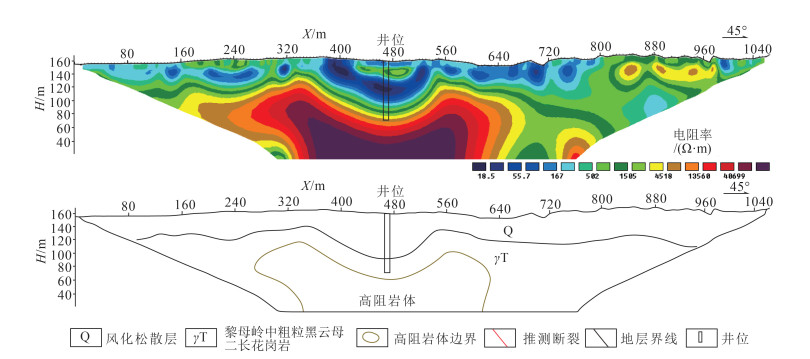Electrical characteristics and storage rules of groundwater in granite area of Qiongzhong County Hainan Province
-
摘要:
海南省琼中县侵入岩分布广泛,历经白垩纪、侏罗纪、三叠纪、二叠纪侵入期,以花岗岩、花岗闪长岩为主。地质构造相对不发育,岩体完整性好,岩石结构致密,地下水富水性差异大,找水难度大。在地质调查、物探勘探、水文钻探相互验证的基础上,较系统地分析了花岗岩区断裂构造裂隙水、风化壳网状裂隙-孔隙水和接触带型基岩裂隙水3种地下水类型的赋存规律及含水层电性特征。研究结果表明,断裂构造裂隙水主要赋存于构造破碎带中,尤其是走向北西的张性或张扭性构造带中,一般富水性好,水量大;风化壳网状裂隙-孔隙水分布普遍,多赋存于沟谷或山间凹谷地貌的风化壳中,一般富水性差,水量小;接触带型基岩裂隙水主要赋存于花岗岩与沉积岩、花岗岩与变质岩、不同侵入期次花岗岩接触带上,富水性差异大。在视电阻率等值线断面上,花岗岩断裂构造裂隙水呈现为陡降低阻"条带"或"漏斗"状异常电性特征曲线;花岗岩风化壳网状裂隙-孔隙水呈现为"洼地"或"凹槽"状低阻电性特征;接触带型基岩裂隙水呈现为"层"或"带"状低阻电性特征曲线。
Abstract:Intrusive rocks, mainly granite and granodiorite, are widely distributed in Qiongzhong County of Hainan Province.They were emplaced in Cretaceous, Jurassic, Triassic, and Permian.It is difficult to find groundwater because of the relatively underdeveloped structure, good integrity and dense structure of rocks and various water richness of groundwater.Based on the mutual verification of geological survey, geophysical exploration and hydrologic drilling, this paper systematically analyzes the electrical characteristics and storage rules of three types of groundwater (structural fissure water, weathered crust netted fissure-pore water and contact bedrock fissure water) in granite area.The research results show that structural fissure water mainly exists in the structural fracture zone, especially in NW-trending tensional structural zones with good water richness and large water volume.The weathered crust netted fissure-pore water is widely distributed, mostly in the weathering crust of gully or mountain valley landform with poor water richness and low water volume.The contact type bedrock fissure water is mainly distributed in the contact zone of granite and sedimentary rocks, granite and metamorphic rocks, and sub-granite of different stages, and its water abundance is greatly different.On resistivity isopleth section, the structural fissure water of granite is electrically characterized by "stripe" and "funnel" abnormal curves with steeply decreasing resistance, and the electrical characteristics of granite weathered crust netted fissure-pore water by "lowland" and "groove" shape low resistance electrical characteristics, and contact bedrock fissure water by "layer" and "band" shape with low resistance.
-
Key words:
- granite /
- types of groundwater /
- storage rules /
- electrical characteristics /
- geophysical exploration
-

-
表 1 单孔最大涌水量及地下水类型划分
Table 1. The maximum water inflow of a single drilling and the classification of groundwater types
村名 井深/m 最大水位降深/m 最大涌水量/(m3·d-1) 区域地层 地下水类型 岸山村 150 36.40 206 二叠纪侵入岩(γP)、长城系戈枕村组(Chg) 接触带型基岩裂隙水 毛枞村 251.82 36.51 720 三叠纪侵入岩(γT)、白垩系鹿母湾组(K1l) 接触带型基岩裂隙水 加剧村 182 32.60 192 三叠纪侵入岩(γT)、白垩系鹿母湾组(K1l) 接触带型基岩裂隙水 深湴村 123 45.60 192 二叠纪侵入岩(γP) 断裂构造裂隙水 深湴村 200 65.00 60 二叠纪侵入岩(γP) 断裂构造裂隙水 上瑞村 179 38.70 192 二叠纪侵入岩(γP) 断裂构造裂隙水 什日宛村 120 43.20 192 二叠纪侵入岩(γP) 断裂构造裂隙水 长征居 220 36.50 480 二叠纪侵入岩(γP) 断裂构造裂隙水 南湴村 202 45.20 268 侏罗纪侵入岩(γJ) 断裂构造裂隙水 干埇村 66 28.60 480 二叠纪侵入岩(γP) 断裂构造裂隙水 大埇村 185 34.70 840 侏罗纪侵入岩(γJ) 断裂构造裂隙水 茅桥 100.66 52.68 150 三叠纪侵入岩(γT) 断裂构造裂隙水 橡胶园 200.16 75.45 187 三叠纪侵入岩(γT) 断裂构造裂隙水 榕木村 168 58.05 603 三叠纪侵入岩(γT) 断裂构造裂隙水 深联队 100 18.99 737 二叠纪侵入岩(γP) 断裂构造裂隙水 山心村 161 29.60 192 三叠纪侵入岩(γT) 断裂构造裂隙水 大丰居 100.2 55.38 241 三叠纪侵入岩(γT) 断裂构造裂隙水 高利埇村 200 60.50 480 三叠纪侵入岩(γT) 断裂构造裂隙水 罗运村 185 30.50 550 侏罗纪侵入岩(γJ) 断裂构造裂隙水 双万村 141 48.10 144 三叠纪侵入岩(γT) 断裂构造裂隙水 头鹿村 160 56.50 60 二叠纪侵入岩(γP) 风化壳网状裂隙-孔隙水 百花村 180 73.30 50 二叠纪侵入岩(γP) 风化壳网状裂隙-孔隙水 槟榔园 213 73.30 57 白垩纪侵入岩(γK) 风化壳网状裂隙-孔隙水 大保村 300.1 36.51 75 三叠纪侵入岩(γT) 风化壳网状裂隙-孔隙水 新进农场五队 120.7 36.31 78 三叠纪侵入岩(γT) 风化壳网状裂隙-孔隙水 新进农场四队 192 78.45 86 三叠纪侵入岩(γT) 风化壳网状裂隙-孔隙水 南吉村 150 32.75 357 三叠纪侵入岩(γT) 风化壳网状裂隙-孔隙水 南吉村 120 51.63 86 三叠纪侵入岩(γT) 风化壳网状裂隙-孔隙水 风流村 171 57.50 132 三叠纪侵入岩(γT) 风化壳网状裂隙-孔隙水 合计 8087 表 2 不同地下水类型含水岩组地球物理特征
Table 2. Geophysical characteristics of water-bearing rock formations of different groundwater types
地下水类型 电阻率值范围/(Ω·m) 电性特征曲线形态 围岩 含水岩组 断裂构造裂隙水 400~9000 50~500 边界清晰,呈陡降低阻“条带”或“漏斗”状异常电性特征曲线 风化网状裂隙-孔隙水 200~5000 10~150 呈“洼地”或“凹槽”状低阻电性特征曲线 接触带型基岩裂隙水 400~7000 100~400 呈“层”或“带”状低阻电性特征曲线 -
[1] 段佳松. 浅层地震折射波法配合电测深法在花岗岩地区找水[J]. 地质与勘探, 1999, (3): 46-48. doi: 10.3969/j.issn.0495-5331.1999.03.014
[2] 田蒲源, 朱庆俊. 综合物探在花岗岩严重缺水区地下水勘查中的应用[J]. 地下水, 2012, (3): 125-127. https://www.cnki.com.cn/Article/CJFDTOTAL-DXSU201203054.htm
[3] 张先林, 许强, 彭大雷, 等. 高密度电法在黑方台地下水探测中的应用[J]. 地球物理学进展, 2017, 32(4): 1862-1867. https://www.cnki.com.cn/Article/CJFDTOTAL-DQWJ201704062.htm
[4] Schirov M, Legchenko A, Creer G. A new direct noninvasive groundwater detection technology for Australia[J]. Explor. Geophys., 1991, 22: 333-338. doi: 10.1071/EG991333
[5] Shen X, Liu L, Li P. Determining water well sites based on electrical structure in Taobei District of Baicheng[J]. Global Geology, 2020, 23(3): 173-179. http://kns.cnki.net/KCMS/detail/detail.aspx?dbcode=CJFD&filename=DBYD202003005
[6] Naziya J, Singh N P. Identification of fracture zones for groundwater exploration using very low frequency electromagnetic (VLF-EM) and electrical resistivity (ER) methods in hard rock area of Sangod Block, Kota District, Rajasthan, India[J]. Groundwater for Sustainable Development, 2018, 7: 195-203. doi: 10.1016/j.gsd.2018.05.003
[7] 杨剑, 王永华, 焦彦杰, 等. EH4电磁系统在西南抗旱救灾找水中的应用[J]. 物探与化探, 2011, 35(6): 754-757. https://www.cnki.com.cn/Article/CJFDTOTAL-WTYH201106008.htm
[8] 吴璐苹, 石昆法, 李荫槐, 等. 可控源音频大地电磁法在地下水勘查中的应用研究[J]. 地球物理学报, 1996, 39(5): 712-717. doi: 10.3321/j.issn:0001-5733.1996.05.015
[9] Chen J, Li Z, Tian B, et al. Using the CSAMT method to predict deep mineralisation of copper and molybdenum: a case study of the Zhongxingtun area in Inner Mongolia, China[J]. Exploration Geophysics, 2020, 51(2): 203-213. doi: 10.1080/08123985.2019.1669441
[10] 潘玉玲, 贺颢, 李振宇, 等. 地面核磁共振找水方法在中国的应用效果[J]. 地质通报, 2003, 22(2): 135-139. doi: 10.3969/j.issn.1671-2552.2003.02.009 http://dzhtb.cgs.cn/gbc/ch/reader/view_abstract.aspx?file_no=20030225&flag=1
[11] Pan Y, Jean B. Surface nuclear magnetic induction system and its' application in hydrogeological investigations[J]. Computerized Tomography Theory and Applications, 2000, 9(2): 37-43. http://www.cnki.com.cn/Article/CJFDTotal-CTLL2000S1008.htm
[12] Legchenko A, Valla P. A review of the basic principles for proton magnetic resonance sounding measurements[J]. Journal of Applied Geophysics, 2002, 50(1): 3-20. http://www.sciencedirect.com/science/article/pii/S0926985102001271
[13] Wattanasen K, Elming S. Direct and indirect methods for groundwater investigations: a case study of MRS and VES in the southern part of Sweden[J]. J. Appl. Geophys., 2008, 66: 104-117. doi: 10.1016/j.jappgeo.2008.04.005
[14] 李慧杰, 朱庆俊, 李伟, 等. 山东临朐新生代玄武岩地下水赋存规律及电性特征[J]. 南水北调与水利科技, 2012, 10(6): 65-69. https://www.cnki.com.cn/Article/CJFDTOTAL-NSBD201206016.htm
[15] 刘伟朋, 卢放, 韩振, 等. 阜平县太古界变质岩区地下水的赋存规律与电性特征[J]. 南水北调与水利科技, 2019, 17(6): 170-177. https://www.cnki.com.cn/Article/CJFDTOTAL-NSBD201906022.htm
[16] 李巨芬, 李伟, 冯庆达, 等. 山东临朐盆地新构造运动特征及其对地下水的控制作用[J]. 水文地质工程地质, 2020, 47(1): 28-36. https://www.cnki.com.cn/Article/CJFDTOTAL-SWDG202001004.htm
[17] 邓启军, 李伟, 朱庆俊, 等. 河北坝上张北县玄武岩区蓄水构造特征与找水实践[J]. 地质通报, 2020, 39(12): 1899-1907. http://dzhtb.cgs.cn/gbc/ch/reader/view_abstract.aspx?file_no=20201204&flag=1
[18] 黄道顺. 花岗岩裂隙水的赋存特征及找水要点[J]. 矿产保护与利用, 2005, 4: 51-54. doi: 10.3969/j.issn.1001-0076.2005.04.014
[19] 张彪, 刘良志, 倪进鑫, 等. 综合物探方法在花岗岩严重缺水地区找水勘查中的应用[J]. 工程地球物理学报, 2015, 12(4): 501-507. doi: 10.3969/j.issn.1672-7940.2015.04.015
[20] 李国占, 王璇. 综合物探在花岗岩地区找水应用效果[J]. 勘察科学技术, 2009, 4: 55-57. https://www.cnki.com.cn/Article/CJFDTOTAL-KCKX200904014.htm
-




 下载:
下载:


